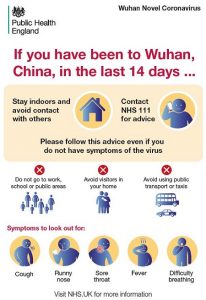
A doctor’s surgery in Brackley has been temporarily closed to be cleared and cleaned because of a corona virus incident.
Please follow the latest government advice:
Situation in the UK
Four patients in England have tested positive for coronavirus. Chief Medical Officer for England Professor Chris Whitty, has shared a statement. If more cases are confirmed in the UK, it will be announced as soon as possible by the Chief Medical Officer of the affected country.
Based on the World Health Organization’s declaration that this is a public health emergency of international concern, the UK Chief Medical Officers have raised the risk to the public from low to moderate. This permits the government to plan for all eventualities. The risk to individuals remains low.
Based on the scientific advice of SAGE the UK Chief Medical Officers are advising anyone who has travelled to the UK from mainland China, Thailand, Japan, Republic of Korea, Hong Kong, Taiwan, Singapore, Malaysia or Macau in the last 14 days and is experiencing cough or fever or shortness of breath, to stay indoors and call NHS 111, even if symptoms are mild.
These areas have been identified because of the volume of air travel from affected areas, understanding of other travel routes and number of reported cases. This list will be kept under review. Our advice for travellers from Wuhan and Hubei Province remains unchanged from the below.
As of 9:00am 09 February, a total of 795 people have been tested, of which 791 were confirmed negative and 4 positive.
We have been working in close collaboration with international colleagues and the World Health Organization to monitor the situation in China and around the world.
Information about the virus
A coronavirus is a type of virus. As a group, coronaviruses are common across the world. Typical symptoms of coronavirus include fever and a cough that may progress to a severe pneumonia causing shortness of breath and breathing difficulties.
Generally, coronavirus can cause more severe symptoms in people with weakened immune systems, older people, and those with long-term conditions like diabetes, cancer and chronic lung disease.
Novel coronavirus (2019-nCov) is a new strain of coronavirus first identified in Wuhan City, China.
Advice for travellers
British people travelling and living overseas following the outbreak of novel coronavirus should check the Foreign and Commonwealth Office travel advice.
The Foreign and Commonwealth Office has advised UK nationals to leave China where possible. If the situation continues to escalate the pressure on the Chinese health system may intensify, and it may also become harder for people to travel.
This change does not affect our advice for those returning from Wuhan or mainland China.
Travellers from Wuhan and Hubei Province
If you have travelled from Wuhan or Hubei Province to the UK in the last 14 days you should immediately:
- stay indoors and avoid contact with other people as you would with the flu
- call NHS 111 to inform them of your recent travel to the area
In Scotland phone your GP or NHS 24 on 111 out of hours. If you are in Northern Ireland, call 0300 200 7885.
Please follow this advice even if you do not have symptoms of the virus.
Travellers from other parts of China and other specified areas
This advice applies to travellers who have returned to the UK from the following areas:
- China
- Thailand
- Japan
- Republic of Korea
- Hong Kong
- Taiwan
- Singapore
- Malaysia
- Macau
If you have returned to the UK from any of these areas in the last 14 days and develop symptoms of cough or fever or shortness of breath, you should immediately:
- stay indoors and avoid contact with other people as you would with the flu
- call NHS 111 to inform them of your recent travel to the country
Please follow this advice even if your symptoms are minor.
What this means in practice
We are asking people to take simple, common-sense steps to avoid close contact with other people as much as possible, like they would with other flu viruses.
This means remaining at home for 14 days after arriving from Wuhan or Hubei Province (or elsewhere in China if you have symptoms) and not going to work, school or public areas.
Where possible, you should avoid having visitors to your home, but it’s ok for friends, family or delivery drivers to drop off food.
Diagnosis and analysis
Based on current evidence, novel coronavirus (2019-nCov) presents with flu-like symptoms including a fever, a cough, or difficulty breathing. The current evidence is that most cases appear to be mild. Those who have died in Wuhan appear to have had pre-existing health conditions.
The UK is now one of the first countries outside China to have a prototype specific laboratory test for this new disease. Healthcare professionals who are contacted by a patient with symptoms following travel to Wuhan have been advised to submit samples to PHE for testing. Individuals should be treated in isolation
After the experience of severe acute respiratory syndrome (SARS) in 2003, PHE developed a series of diagnostic tests to detect any member of the family of coronaviruses. These have been used for several years, and were able to detect the first UK case of Middle East respiratory syndrome (MERS) in 2012.
With the first reported publication of the genome sequence of a 2019 novel coronavirus, PHE was able to rapidly develop further specific tests for this virus, working with WHO and global network of laboratories.
When a clinician suspects novel coronavirus (2019-nCov), they take samples from the nose, throat and deeper respiratory samples, package and send them safely to PHE Colindale. PHE can provide a laboratory result from this specific virus on the same working day.
PHE also has the capability to sequence the viral genome and compare this to published sequences from China, if a case occurs. This will provide valuable information on any mutations in the virus over time and allow an improved understanding of how it spreads.









